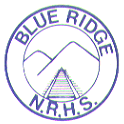Wednesday, February 20, 2002, dawned cold and rainy in north Georgia. I was up at 5 a.m. for the one-and-a-half hour drive north to Blue Ridge where I would meet Carl, the Georgia Northeastern Railroad engineer I would be working with that day. I had taken a day off from my full-time job in Atlanta to work on the weekly "log train" the GNRR ran between Blue Ridge to Tate, 42 miles south.
I would not be paid for working the freight train; I was strictly a volunteer. However, the opportunity to work a freight train through the North Georgia Mountains was payment enough. Besides, if they paid me, I would feel like I had to do it and it would become just another job. Working on the GNRR freight train was certainly more exciting and physically demanding than my regular weekend stint as a volunteer conductor on GNRR subsidiary, Blue Ridge Scenic Railway, hauling excursions from Blue Ridge 13 miles north to Copperhill, TN.
Carl and I went on duty in Blue Ridge at 8 a.m. Although I assumed we would take a load of logs southward, he informed me that we would "deadhead" to Tate in GNRR T-4, affectionately known as "Old Yeller," one of the GNRR's bright yellow pickup trucks.
At this point in the log train's short history, the railroad was averaging two trains a week. The previous day's crew "went on the law" the night before and had to leave the locomotives at Tate and drive back to Blue Ridge in Old Yeller. The Federal Hours-of-Service Law limits train crews to 12 hours on duty. Given that the GNRR freight trains were limited to 10 mph, driving Old Yeller at 55 mph on the four-lane made for a much quicker but less exciting trip to Blue Ridge
We arrived at Tate around 9 o'clock to discover one of our two locomotives with its nose protruding out of the shop doorway. This did not bode well for a quick return to Blue Ridge. We assumed we might have to fuel and sand the engines before leaving Tate, but we were not prepared to see one of them in the shop. A battery replacement and repairs to the locomotive's air brakes meant we would be delayed.
Neither of us complained about waiting for the brakes to be fixed; we had several long, relatively steep hills to contend with on our way back to Blue Ridge. The first being the 5-mile, twisting 2 percent grade at Cagle Mountain as the tracks wound down between Jasper and Talking Rock. A second hill farther north at Ella Gap could also be dicey without effective brakes. Because of our slow operating speeds, the GNRR locomotives were not equipped with dynamic brakes and relied totally on air brakes when descending grades.
Anticipating several hours delay, I grabbed the digital camera I always carried with me on my freight runs and began taking photographs around the shop and yard. As expected, the sunless sky, gray overcast, and morning mist provided limited opportunities for pictures with good contrast, but locomotives and freight cars make interesting subjects for railroad aficionados in any light. Besides, the GNRR's red and silver paint scheme made their locomotives show up under even the worst lighting conditions.
It wasn't long before I heard the North Local blowing its horn for the GA Route 53 grade crossing at Tate Depot. I made several shots of the train as it brought a load of empty log racks and hopper cars into the yard. The crew parked the locomotives in the two-mile long Tate Siding and uncoupled GNRR 315, the lead engine, to use as the yard switcher. Their first order of business was to shove the empty log racks back south on the main track for Carl and I to pick up when our engines were ready.
A short time later, the switcher headed back into the yard and down the Georgia Marble Lead, a 4 percent grade with two switchbacks that led to the marble quarries that were the impetus for originally building the narrow-gauge Marietta and North Georgia Railroad, one of the GNRR predecessors, back in the 1870s. There, the crew would pick up two or three cars of marble slurry - the most that could fit on the switchbacks – bound for the carpet mills up in Dalton or the newsprint plants down south.
The brakeman had lined the switch into the Georgia Marble lead and was about to climb aboard for the ride "down the hill" when I snapped a picture. Unfortunately, my camera was at its limits for capturing good resolution under the existing conditions, especially when zoomed to 3X. However, it captured the mood perfectly.

Photo by Bob Ciminel ©2007
Our day ended at 8 o'clock that night when we shoved our empty log racks into the Byrant Timber siding north of Blue Ridge Depot and parked our locomotives on the main track ready for the weekend tourist operation. It was a long day, and I worried about staying awake for the two-hour drive back home. A big cup of coffee would take care of the drowsiness, and the Oldies station in Ellijay would relieve the boredom. All in all, it was not a bad way to spend a day of vacation.


